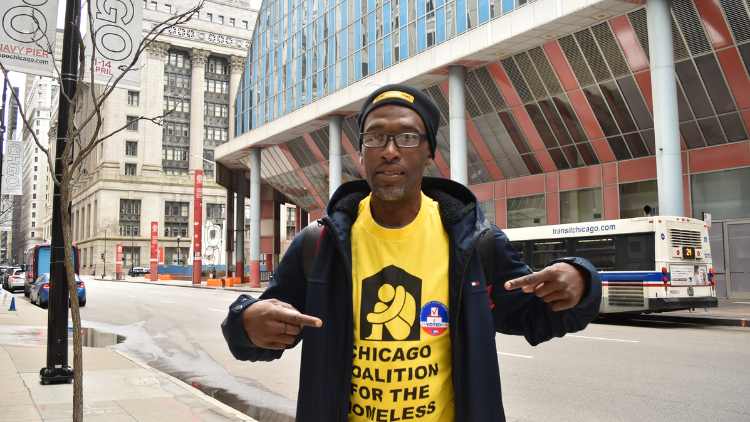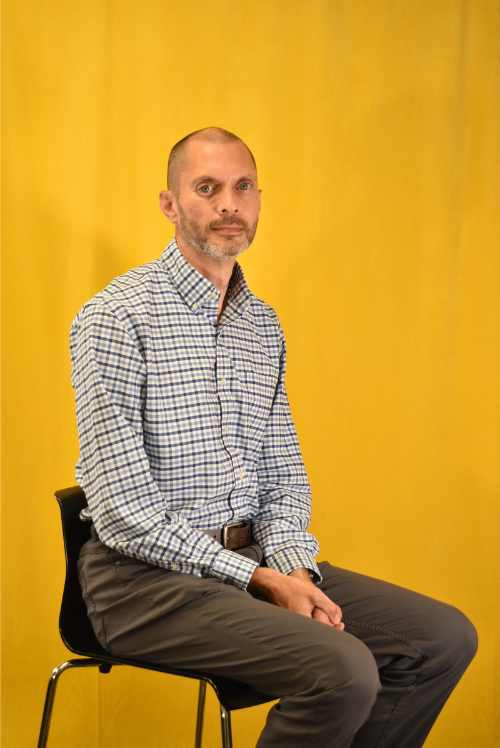A Chicago Defender article from 1946 that chronicles the Hemmons family becoming unhoused.
This is Part Three of the Chicago Defender’s series Black and Unhoused: How Segregation Fueled a Homegrown Crisis, which is part of the “Healing Illinois” initiative.
The story of the Hemmons family is where racist policy, poverty and a lack of affordable housing options converge.
Carey Hemmons, his wife and 11 children were evicted from their South Side apartment in Chicago’s storied Black Belt nearly 80 years ago.
According to a 1946 Chicago Defender article, the Board of Health forced this Black family to leave because their cramped dwelling was deemed “unsanitary,” resulting in “overcrowded conditions.”
[perfectpullquote align=”full” bordertop=”false” cite=”” link=”” color=”” class=”” size=””]With few options, the Hemmons took up residence in the alley behind their former home, which the report described as a “scene of misery and fear.” [/perfectpullquote]
According to the story, one official agency reached out to lend a helping hand while another told them to “report to the nearest police station.”
A lot has changed since the Defender chronicled the plight of the Hemmons family. Today, Black Chicagoans who are unhoused or on the verge of becoming homeless have more services available to them.
They do not suffer the same constraints as the Hemmons, who were bound by racist, restrictive covenants of the past and disallowed from seeking housing in nearby predominantly White and European immigrant communities.
Thanks to the efforts of Carl Hansberry and later the Dr. Martin Luther King Jr., James Bevel, and Al Raby-led Chicago Freedom Movement, the Fair Housing Act of 1968 was ratified, and restrictive covenants were outlawed.
What Chicago’s unhoused population and those on the verge of losing their homes face today is similar to what the Hemmons family endured back then. But politics and entrenched segregation by race and class do the work restrictive covenants once did.
Moreover, organizations that advocate for the homeless and affordable housing argue that Chicago residents recently had an opportunity to vote for a transfer tax known as Bring Chicago Home that would’ve helped to change the fortunes of thousands of unhoused persons and those on the verge of losing their homes.
Instead, the March 19 ballot measure was soundly defeated.
With that setback, a familiar theme prevailed, one that governed the lives of families like the Hemmons and thousands of others, especially those who were Black and poor.
“The powers that be have always pushed back on efforts to make access to housing more just because it undermines their profits and their power,” said Douglas Schenkelberg, executive director of the Chicago Coalition for the Homeless. “And so the loss of the referendum question (Bring Chicago Home) is yet another example of the status quo working to maintain the status quo.”
To Schenkelberg and other BCH supporters, those who voted ‘no,’ many of whom were persuaded by Chicago’s business and real estate interests, killed what they believed was the most concrete solution to address homelessness at scale in Chicago.
Bring Chicago Home: A Realization and Resolve

Brian Rodgers (Credit: Chicago Coalition for the Homeless).
“Bring Chicago Home” was years in the making. The effort was spearheaded by a coalition of advocates who wanted to establish a lasting solution to the age-old problems of homelessness and affordable housing access in the city.
Movement leaders included the perspectives of individuals who had experienced homelessness. They believed their fight needed credible voices who could authoritatively speak to the value and need for stable, affordable housing.
One of those persons is Brian Rodgers, who was homeless due to years of going in and out of prison while grappling with mental health and substance abuse issues.
After his last stint in prison, he entered Saint Leonard’s, a 70-year-old nonprofit organization on the West Side that provides housing to formerly incarcerated persons.
While touring the city he had known for most of his life, Rodgers observed a growing problem.
“I saw all these people around Union Station just walking through the downtown area on my way to Saint Leonard’s,” he said.
“I was seeing people just laying literally on the streets.”
Then Rodgers noticed tent encampments set up in various parks. When he glimpsed the conditions of a city shelter, he began to comprehend the extent of the issue.
“It was just a million people everywhere. Total chaos as far as I was concerned,” he said. “And I was like, ‘How is somebody supposed to get themselves together in an atmosphere like this?'”
He also witnessed people sleeping on CTA trains when he worked a night job out by O’Hare. He knew homeless people would seek shelter on the trains, but not to this magnitude.
Then there were his experiences of not having a place to lay his head, a home of his own.
Rodgers couch-surfed and doubled up with friends and people he knew from his old neighborhood.
He also squatted in a few apartment buildings around the city, including one where the owner actually commended him and his mates for taking care of the property.
“‘You guys are keeping it up for me, keeping it safe, and letting nobody take anything, so you can stay here,'” Rodgers said, chuckling as he recalled the owner’s words.
But he would eventually have to leave once the property was sold.
Yet, all those experiences, including having about $15 to his name upon his release from prison and navigating a complex parole system, made him come to a startling realization.
“The light bulb just finally clicked to say, ‘Hey, you haven’t had a place to stay. Have you ever thought about all the times you went back to doing what you were doing or felt the pressures of having to find somewhere to stay to get on your feet and everything, that you were making these hasty decisions?” he said.
[perfectpullquote align=”full” bordertop=”false” cite=”” link=”” color=”” class=”” size=””]”It’s because you didn’t have the opportunity to have stable housing.”[/perfectpullquote]
That realization crystallized into a resolve to do something.
While Rodgers stayed at Saint Leonard’s, he connected with the Chicago Coalition for the Homeless through a workshop where he learned about his rights as a person returning from incarceration. Through a CCH reentry organizer, he learned about “Bring Chicago Home” and decided to join the movement.
After attending a few BCH meetings, Rodgers started providing ideas from his experience.
“It was like a dual embracement between me and CCH. The more I came down there, the more I was embraced.”
“I said to myself, ‘Hey, this is where I need to be,'” he said. “This is where I need to be as far as making a difference.”
A ‘Chicago Dilemma’
“Chicago Dilemma: Family of 13 Homeless,” read the headline of the 1946 Defender article that chronicled the predicament of the Hemmons family.
The report features a photo of most of the family members in the alley behind their former home.
“Victims of poverty and the housing shortage, Mr. and Mrs. Carey Hemmons, and eight of their 11 children huddle around their stove in the alley into which they were evicted from a one-room garage apartment at 4231 Evans Ave., read the caption — a familiar plight for many today.
Bring Chicago Home sought to help two groups: people already unhoused and in need of shelter and those on the verge of losing their homes.
According to proponents, BCH would have incrementally raised the city’s real estate transfer tax on properties valued at more than $1 million. The transfer tax would have generated $100 million yearly for mental health services, job training and educational opportunities for the unhoused.
While acknowledging that homelessness in the city needed to be addressed, the Building Owners and Managers Association of Chicago and other parties sought to remove the measure from ballots, arguing that BCH would deter businesses from moving to the city.
The Civic Federation also concluded that the measure didn’t specify how funds generated from the transfer tax would be used.
However, Schenkelberg said BCH monies would have funded two large-scale solutions that would effectively address homelessness in the city.
Proven Solutions to Address Homelessness

A homeless person trying to shelter themselves from the elements in a doorway (Credit: Colin Davis, Flickr).
The programs Schenkelberg is referring to are the Homelessness Prevention Program and Housing First.
The former is a state initiative that provides help with rent or a mortgage, utilities, case management and support services to people on the verge of eviction, foreclosure, homelessness or who are already homeless.
“So it might be that they were hit with medical bills that made it hard for them to pay rent, or they lost their job, and they’re temporarily out of employment,” Schenkelberg said.
The Homelessness Prevention Program “provides a bridge to get people through crises so that they don’t lose their housing, be it if they’re a homeowner or renter, during that period of crisis.”
[perfectpullquote align=”full” bordertop=”false” cite=”” link=”” color=”” class=”” size=””]Schenkelberg added, “Because there are a lot of folks who hit those moments. It’s a very common thing, right? They’re paycheck to paycheck. They’re one crisis away from things falling apart, so having that safety net at that moment is really important.” [/perfectpullquote]
He said that rental assistance programs help people keep their homes.
Some studies support Schenkelberg’s assertion.
A 2021 University of Notre Dame Homelessness Prevention Call Center study found that if emergency funds were available to someone when they called, they were 88% less likely to be homeless after three months and 76% less likely after six months.
Moreover, the study outlined the cost savings that rental assistance programs could provide.
Researchers estimated that the cost of someone enduring a single spell of homelessness was around $20,548. However, with the help of an emergency financial assistance program, the cost to keep that same person housed would be about $10,300, nearly half the amount.
The Housing First program, the other initiative that would have received funding had BCH passed, is premised on the idea that the best way to move someone out of homelessness is to immediately put them into permanent housing without conditions.
“Someone might be dealing with mental health issues, or they might be dealing with substance use issues. You don’t tell them, ‘You have to be clean before you get housing,'” said Schenkelberg.
“You don’t tell them, ‘You have to be regularly taking your medication before you get housing. Because the reality is that dealing with those issues is a lot easier when someone is stably housed rather than if they’re living in an encampment.”
In addition to housing, those enrolled in a Housing First program, like the one administered by the Illinois Department of Human Services, receive support services for whatever issue they’re dealing with, such as mental health and substance use treatment and job training.
Multiple sources have also concluded that “Housing First” programs are more effective at keeping people stably housed than “Treatment First” programs, which require enrollees to be free of substance use or psychiatric treatment before receiving housing.
A 2021 report published in the Journal of Public Health Management & Practice cited 26 studies. It concluded that Housing First programs decreased homelessness by 88% compared to Treatment First initiatives and improved housing stability by 41%.
However, Housing First programs like the one in Chicago were funded by pandemic recovery dollars, which are quickly drying up.
“The ability to maintain that program is limited because you don’t have, at this point, something like Bring Chicago Home in the pipeline,” Schenkelberg said.

Doug Schenkelberg of the Chicago Coalition for the Homeless (Credit: Chicago Coalition for the Homeless).
Ultimately, the lack of funding means the Housing First program cannot serve the tens of thousands of Chicagoans needing a home.
The Homelessness Prevention program faces the same predicament: a lack of a sustainable revenue stream to assist the multitude of individuals facing homelessness.
For instance, a University of Chicago assessment called “Helping Chicagoans Stay Stably Housed” examined the promise and challenges of Chicago’s Homelessness Prevention Call Center.
The report’s authors found that while the program effectively helped people avoid evictions, it could not sustainably serve all who met the criteria for emergency assistance, especially during the pandemic.
They also observed that short-term financial and rental assistance funding gets expended yearly, and funding levels fall well short of the demonstrated need.
For Schenkelberg and many who work on behalf of the unhoused in Chicago, the great dilemma is knowing that programs that can effectively address homelessness exist but that there isn’t a sustainable funding stream to address large-scale homelessness in the city.
“Are we investing funding at scale in these proven solutions that we can have a measurable impact on the problem?” Schenkelberg said.
As for the business and real estate interests that opposed BCH, Schenkelberg poses this challenge:
“You’ve said multiple times throughout the campaign and after election day that you think addressing homelessness is a very important issue, that it’s something we have to tackle in the city of Chicago,” he said.
“So how are you going to step up in a way that’s meaningful and has a measurable impact on the 68,000 people experiencing homelessness in Chicago? How will you show up differently than you’ve shown up before Bring Chicago Home?”
The Story and Fight Continues
No other retrievable record from The Chicago Defender archives shows what became of the Hemmons family.
The only information we have is what was included in the story detailing the immediate aftermath of their eviction.
“It seems to be strictly a case of “damned if you do and double damned if you don’t,” as the Hemmons look in vain for a helping hand,” the report stated. Even the creaking boards, scampering insects and ever-present filth of the garage room is preferable, they feel, to the open sky for a roof and the cold concrete as a floor.”
According to the Defender article, the Housing Authority did not consider their case because it did not have accommodations for families with 11 children. The Hemmons could not get welfare because they had no permanent address. They even went through their savings because Carey had to leave his job as a mover’s helper to find housing for his family.
Neighbors provided food, and a church located on what is now known as King Drive gave them a place to sleep at night. Someone from a group called the United People’s Housing Committee tried to help them find a home.

The Chicago Defender chronicling the Hemmons family becoming homeless.
But it isn’t known whether they landed on their feet or what became of their family’s descendants.
Whether the Hemmons found a home or not is shrouded by the irrefutable fact that the struggle for equitable, affordable housing for Black people in Chicago persists some eight decades later.
This time around, the fight still centers around BCH, which supporters contend is not dead.
They vow not to give up.
They believe they have a measure that could disrupt a persistent narrative and resolve a problem that has impacted Black people the most.
“There were 68,000 people experiencing homelessness before Election Day, and there are 68,000 people experiencing homelessness after it, so one election doesn’t change our course over the long term,” said Schenkelberg.
“The work goes on, and we only honor the people who have fought for this for years by continuing to do the work.”
VIDEO STORY: Black and Unhoused in Chicago: How Housing Segregation Fueled a Homegrown Crisis
This article is part of the Segregation Reporting Project, made possible by a grant from Healing Illinois, an initiative of the Illinois Department of Human Services and the Field Foundation of Illinois that seeks to advance racial healing through storytelling and community collaborations.
The project is inspired by “Shame of Chicago, Shame of a Nation,” a new documentary that addresses the untold legacy of Chicago’s systemic segregation.
Managed by Public Narrative, this endeavor enlisted five local media outlets to produce impactful news coverage on segregation in Chicago while maintaining editorial independence.



